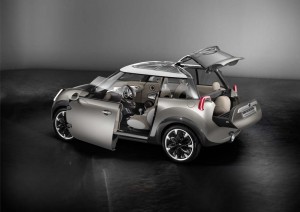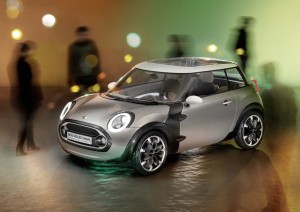Few automakers have undergone a more rapid brand expansion than Mini, the British marque that seems to be flooding the automotive world with new concepts and production cars.
Mini raised some eyebrows with the launch of the Countryman, last year, which was not only its largest-ever model, but its first crossover, first 4-door and first use of all-wheel-drive. But for the upcoming Geneva Motor Show, the maker is moving in a decidedly different direction.
If anything, the Mini Rocketman Concept is a return to the brand’s classic roots. But don’t think Mini is playing it safe. Just 3.4 meters (about 11 feet) in total length Rocketman is a microcar that still delivers enough interior space for four passengers.

The Mini Rocketman features wide-opening, double-hinged doors and a dual hatch with a pull-out drawer.
Well, make that 3+1, the maker says of the design study, a three-door that also features a split rear hatch, the lower portion of which functions as a pull-out storage bin. The front doors, incidentally, are double-hinged to open wide and make it especially easy for rear passengers to get inside.
The debut of the Mini Rocketman underscores some of the dramatic changes sweeping through the global auto industry. The Mini Cooper, which seemed, just a few years ago, to be such a tiny offering is now almost mainstream compared to even smaller models like the Smart fortwo, Fiat 500 and Toyota iQ.
Nose-to-tail, the Mini Rocketman is a fair bit smaller than the Cooper, and only a couple inches longer than the original Mini launched in 1959.
Those products are targeting a new generation of urban-oriented buyers who want to be able to maneuver crowded city streets and get great mileage, but who don’t want to settle for the classic stripped-down econoboxes of the past.
Significantly, Mini has adopted a carbon-fiber spaceframe design that is both lightweight yet incredibly strong. Until now, the material has had to be largely handcrafted, and that has meant a hefty price tag, but Mini’s German parent, BMW, has been making major investments in carbon fiber technology – and the Rocketman concept suggests that perhaps the material is poised to migrate into more mainstream segments.
When it comes to the drivetrain, Mini’s advance release is a bit coy, speaking of a “drive system which combines enhanced sprinting ability with average fuel consumption of just three liters per 100 kilometers.” In U.S. terms, that works out to around 76 miles per gallon – and almost certainly suggests some form of electrification is in use. Mini is already pushing into battery power and the Rocketman is a likely demonstration platform to show where the brand expects to go next.
As the name might imply, the Rocketman explores the use of a variety of advanced materials and technology, including LED lighting inside and out. A new steering wheel-mounted trackball is intended to make it easier to operate the car’s infotainment system – which includes 3D-effect graphics in the center speedometer.
The Mini Connected control unit can be removed and pre-programmed using a home or laptop computer, allowing the easy download of music and other data files.
Is the Mini Rocketman destined for production? The maker has been adding a number of new models, of late, everything from coupes to crossovers. But in an interview with TheDetroitBureau.com, earlier this year, Mini USA CEO Jim McDowell hinted that there could be room for another “interesting” model in the line-up. Perhaps the new microcar could rocket into that empty slot?

